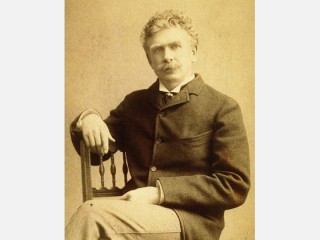
Ambrose Bierce biography
Date of birth : 1842-06-24
Date of death : -
Birthplace : Meigs County, Ohio
Nationality : American
Category : Famous Figures
Last modified : 2010-11-26
Credited as : Writer, ,
The American writer Ambrose Gwinett Bierce (1842-c. 1914) expressed the cynicism of the post-Civil War era and shaped both the materials and the methods of writers who later voiced the disillusionment following World War I.
Ambrose Bierce was born in Meigs County, Ohio, and reared in Kosciusko County, Ind. He was a printer's apprentice before enlisting and serving with distinction in the Civil War. He launched a journalistic career in California and continued it in London from 1872 to 1876. There he served on the staffs of the magazines Fun and the Lantern, contributed to Hood's Comic Almanac, and under the pseudonym Dod Grile published the books Fiend's Delight (1872), Nuggets and Dust Panned Out in California (1872), and Cobwebs from an Empty Skull (1874). Back in California he became an outstanding contributor to William Randolph Hearst's San Francisco Examiner. In 1897 he went to Washington, D.C., as a correspondent for the Hearst papers.
Bierce won attention as a fiction writer with Tales of Soldiers and Civilians (1891), later titled In the Midst of Life (1892, revised and republished 1898), and Can Such Things Be? (1893). Both collections were reminiscent of Edgar Allan Poe's tales of terror, but Bierce's stories were often sardonic in tone and built to surprise endings. Other books that helped him win the nickname "Bitter Bierce" included collections of witty satirical verses, Beetles in Amber (1892) and Shapes of Clay (1903). The Cynic's Word Book (1906), retitled The Devil's Dictionary when it was reissued in 1911, was a gathering of succinct, witty, and usually vinegarish definitions; for example: "Patriotism, n., Combustible rubbish ready to the torch of anyone ambitious to illuminate his name"; "Edible, adj., Good to eat, and wholesome to digest, as a worm to a toad, a toad to a snake, a snake to a pig, a pig to man, and a man to a worm." In Fantastic Fables (1899) Bierce adapted Aesop's techniques to narratives which moralized about the day's economic, social, and political dilemmas, and The Shadow on the Dial (1909) brought together a number of disillusioned essays.
Bierce spent several years editing his Collected Works (12 vols., 1909-1912). In June, 1913, he wrote a friend, "Pretty soon I am going … very far away. I have in mind a little valley in the heart of the Andes, just wide enough for one…. Do you think I shall find my Vale of Peace?" The next year Bierce went to Mexico, at that time torn and disrupted by civil war, and he disappeared.
Bierce's stress in his war stories on the psychological and physical impacts and on the meaninglessness of conflict anticipated Stephen Crane and the many writers who expressed disillusionment after World Wars I and II. Bierce mingled foreign phrases, latinate words, and vernacular phrasings in anticlimactic and periodic sentences to express forcibly his cynical attitude. His style foreshadowed that of one of the most influential American writers of the skeptical 1920s, H. L. Mencken.
Bierce's Collected Works (12 vols., 1909-1912) brings together a large share of his literary and journalistic writings. Bertha C. Pope edited Letters of Ambrose Bierce (1922). The two best biographical and critical studies are Paul Fatout, Ambrose Bierce: The Devil's Lexicographer (1951), and Richard O'Connor, Ambrose Bierce (1967).
Bierce, Ambrose, Ambrose Bierce's Civil War, Washington, D.C.: Regnery Gateway; New York, N.Y.: Distributed by Kampmann, 1988.
De Castro, Adolphe Danziger, Portrait of Ambrose Bierce, New York, Beekman Publishers, 1974.
Grattan, C. Hartley (Clinton Hartley), Bitter Bierce; a mystery of American letter, New York, Cooper Square Publishers, 1966.
Morris, Roy, Ambrose Bierce: alone in bad company, New York: Crown Publishers, 1995.
Saunders, Richard, Ambrose Bierce: the making of a misanthrope, San Francisco: Chronicle Books, 1985.
















